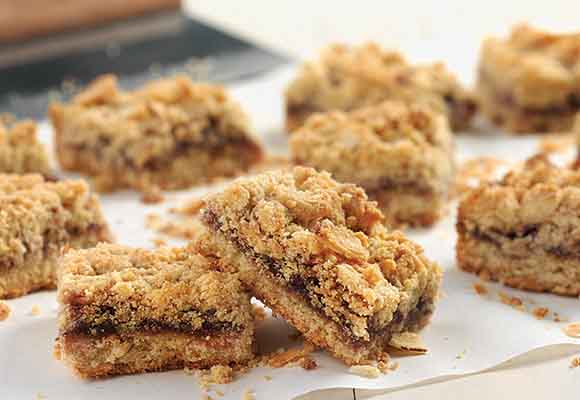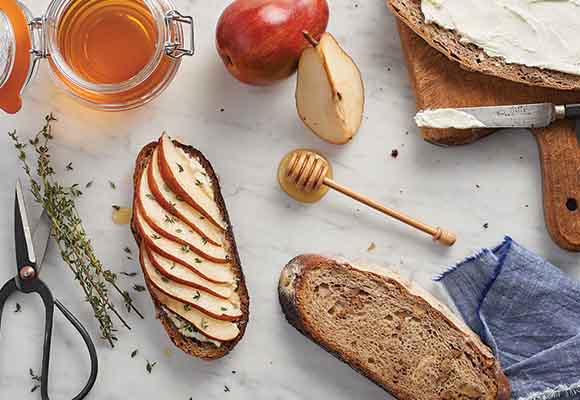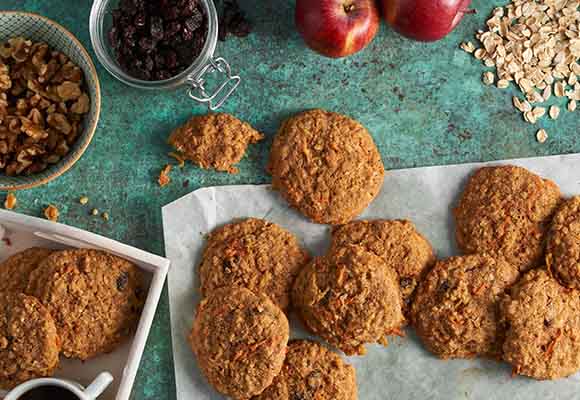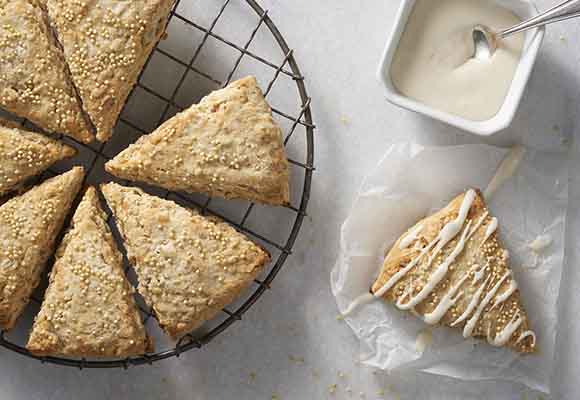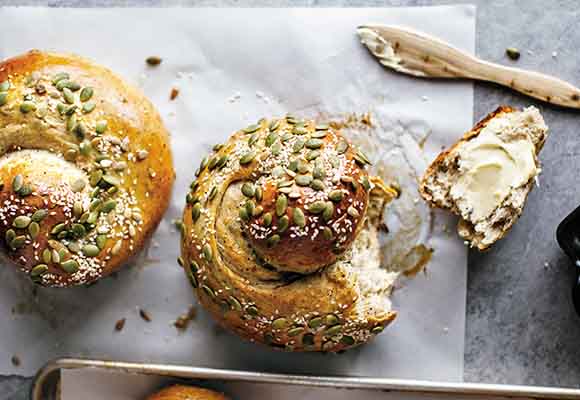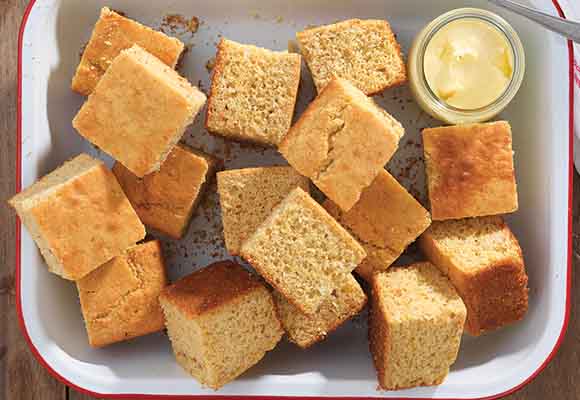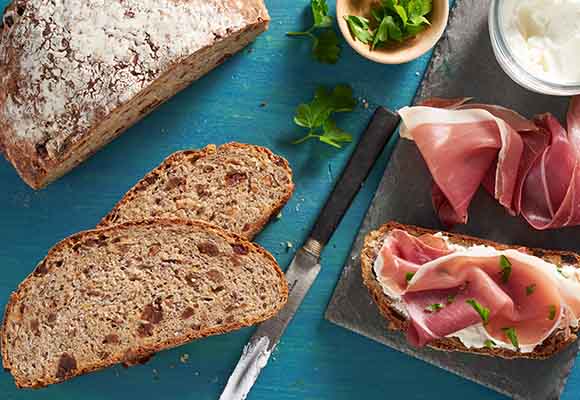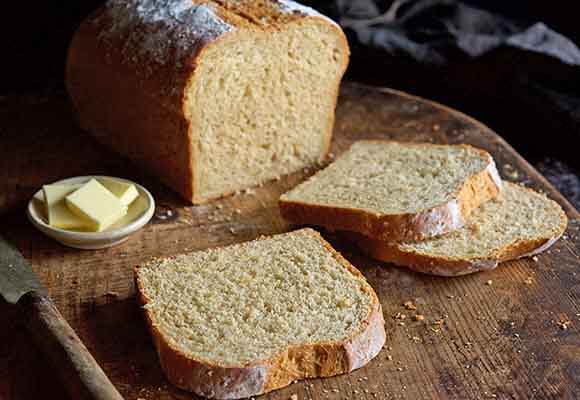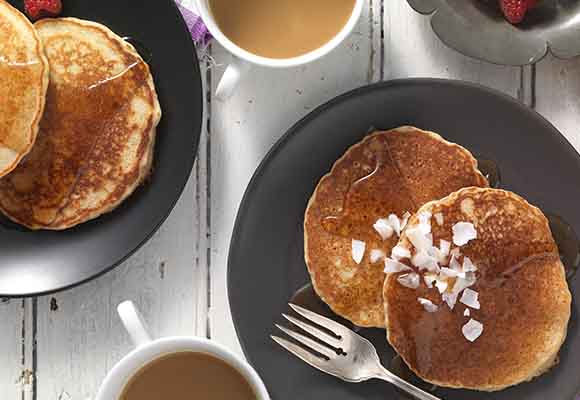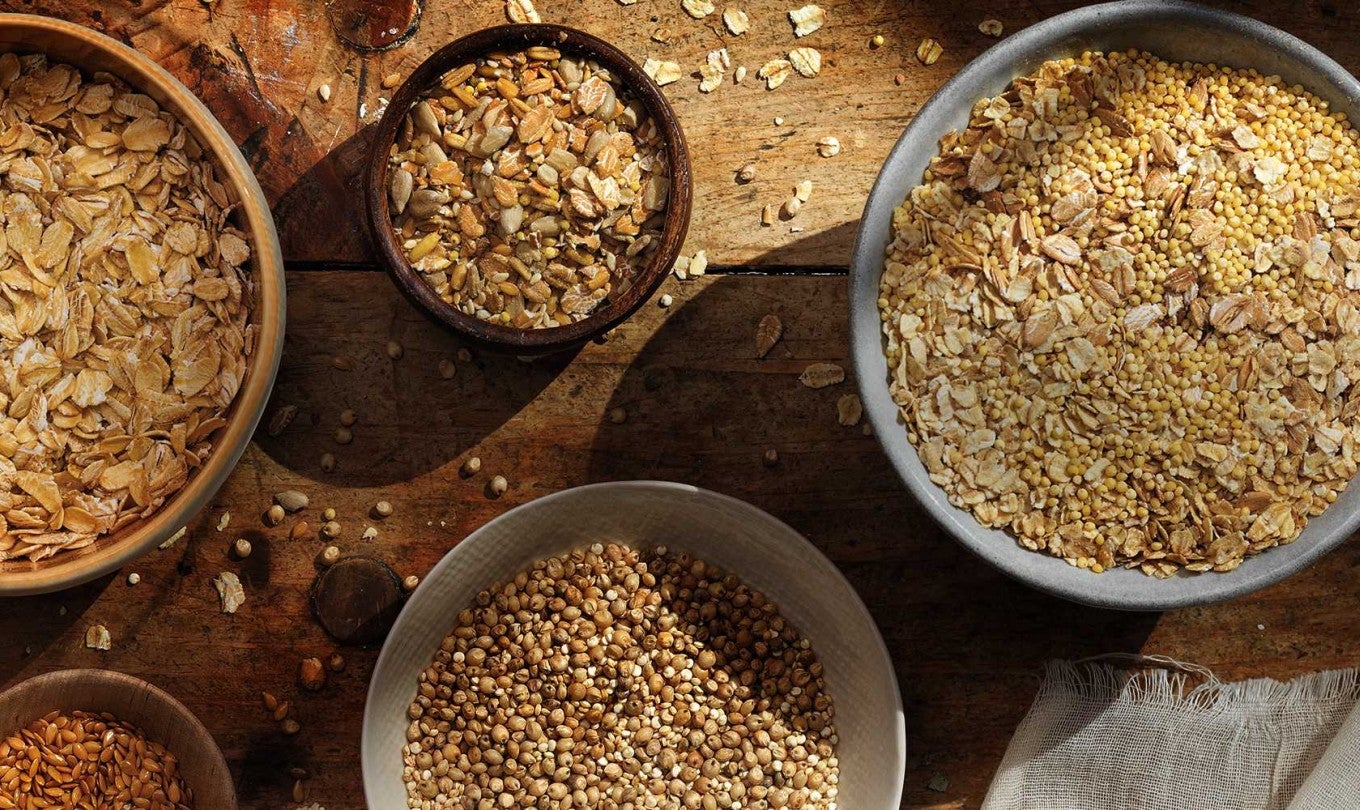
Baking with Ancient Grains
Amaranth Flour
Amaranth flour is versatile, full of whole-grain nutrition, and enhances the flavor of many recipes. Naturally gluten-free, it contains all nine essential amino acids and lysine, a protein missing in most grains. Amaranth is a good source of iron, magnesium, and phosphorus.
- Flavor: Earthy and peppery.
- Texture effect: Tender in small amounts; dense in larger quantities.
- Works best in: Pancakes and quick breads.
- Gluten-free: Yes.
How to incorporate amaranth flour into your baking
As with many ancient grains, amaranth flour is versatile enough to substitute into many standard recipes. To find the best combinations, our test kitchen bakers took five of our most popular recipes and replaced a portion of the all-purpose flour with amaranth flour. The results were delicious. Some recipes came alive with a half-and-half substitution: 50% amaranth, 50% all-purpose. Others worked best with amaranth at 25%. Here are our full findings for pancakes, scones, cinnamon bread, banana bread, and muffins. Learn more about the testing process on our blog »
Amaranth in Pancakes
We really like the flavor of 50% amaranth and 50% all-purpose flour. The pancakes are fluffy and more tender than those made with all-purpose flour alone. If you're feeling adventurous, substitute up to 100% amaranth, though that amount yields a real punch of flavor.
We also liked: Spelt
Get the recipe »Amaranth in Scones
Substituting 25% yields a tender, crumbly texture in scones. The mild amaranth flavor adds some complexity without overwhelming other flavors. Substituting amaranth 100% yields a denser scone with a much grittier bite and a nutty, almost peanut butter-like flavor.
We also liked: Kamut
Get the recipe »Amaranth in Cinnamon Bread
Cinnamon bread demonstrates that amaranth inhibits breads' rise. A yeast loaf baked with 25% amaranth flour is acceptable, but loaves using 50% amaranth flour or more are incredibly dense and barely rise. If you're determined to make a yeast loaf that's more than half amaranth flour, add a little extra water and prepare for a heavy loaf.
We also liked: Kamut or Spelt
Get the recipe »More great amaranth recipes
Barley Flour
Barley flour is exceptionally high in fiber and low in starch, making it one of the lowest glycemic index (GI) grains you can use. With three times the soluble fiber of oats, it's a delicious, nutty-tasting way to add nutrition to baked goods.
- Flavor: Subtly sweet and nutty.
- Texture effect: Often moist in small amounts; crumbly in larger quantities.
- Works best in: Pancakes and quick breads.
- Gluten-free: No.
How to incorporate barley flour into your baking
As with many ancient grains, barley flour is versatile enough to substitute for all-purpose or whole wheat flour in many standard recipes. To find the best combinations, our test kitchen bakers took five of our most popular recipes and replaced a portion of the all-purpose flour with barley flour. The results were delicious. Some recipes came alive with a complete substitution: 100% barley, 0% all-purpose flour. Other recipes worked best at 50% or 25% barley. Here are our full findings for pancakes, scones, cinnamon bread, banana bread, and muffins. Learn more about the testing process on our blog »
Barley in Pancakes
You'll love the extra-fluffy pancakes you'll make using 100% barley flour. Barley adds a touch of sweet nut-like flavor, which gives these breakfast cakes a bit of sophisticated taste.
We also liked: Spelt
Get the recipe »Barley in Banana Bread
Banana bread made with 50% barley flour has the ideal balance of banana, spice, and nutty flavors. It's also deliciously moist, and rises well. A 100% barley flour loaf sinks a little, and is tough, dense, and gummy — although the flavor continues to shine.
We also liked: Quinoa
Get the recipe »Barley in Muffins
Muffins made with 50% barley flour are lofty and domed, and just as tasty as they are beautiful. Moist and tender, they perfectly highlight the sweet, nutty flavor of barley. For a muffin with even more flavor (but a flatter, denser texture), substitute barley flour 100%.
We also liked: Quinoa
Get the recipe »Buckwheat flour
Buckwheat flour is hearty, gluten-free, and a good source of magnesium, copper, and dietary fiber. We enjoy its health benefits, but also turn to it again and again for its bold, nutty flavor.
- Flavor: Bold, toasty, and rich.
- Texture effect: Moist and tender in small amounts; chalky in larger quantities.
- Works best in: Pancakes and quick breads.
- Gluten-free: Yes.
Try buckwheat flour in your kitchen.
How to incorporate buckwheat flour into your baking
As with many ancient grains, buckwheat flour is versatile enough to substitute for all-purpose or whole wheat flour in many standard recipes. To find the best combinations, our test kitchen bakers took five of our most popular recipes and replaced a portion of the all-purpose flour with buckwheat flour. The results were delicious. Some recipes came alive with a full substitution: 100% buckwheat, 0% all-purpose flour. Others worked best at 50% or 25%. Here are our full findings for pancakes, scones, cinnamon bread, banana bread, and muffins. Learn more about the testing process on our blog »
Buckwheat in Pancakes
We found a 50% buckwheat and 50% all-purpose flour combination the most appealing. You'll enjoy buckwheat's distinctive flavor in a fluffy, moist pancake. At 100% buckwheat, pancakes will be dry and somewhat sandy, with assertive buckwheat flavor.
We also liked: Quinoa
Get the recipe »Buckwheat in Scones
Scones made with 25% buckwheat flour will be moist and tender, and have delicate buckwheat flavor. Beyond 50%, scones will have a pronounced "grassy" note, and chalky texture.
We also liked: Kamut
Get the recipe »Buckwheat in Muffins
Substituting buckwheat flour 25% in muffins seems to yield the best results: muffins are moist yet light in texture, with enjoyable buckwheat flavor. As you increase the amount of buckwheat beyond 25%, muffins become drier and chalkier.
We also liked: Quinoa
Get the recipe »Kamut flour
Kamut flour, a good source of protein and dietary fiber, contains some gluten. Kamut, the commercial name for Khorasan wheat, is an ancient variety of durum, with a grain twice the size of modern-day wheat.
- Flavor: Rich and buttery.
- Texture effect: Light and tender in small amounts; verging on crumbly in larger quantities.
- Works best in: Scones, quick breads, and muffins.
- Gluten-free: No.
How to incorporate Kamut flour into your baking
As with many ancient grains, Kamut flour is versatile enough to use in many standard recipes. To find the best combinations, our test kitchen bakers took five of our most popular recipes and replaced a portion of the all-purpose flour with Kamut flour. The results were delicious. Some recipes came alive with a half-and-half substitution: 50% Kamut, 50% all-purpose. Others worked best at 25%. Here are our full findings for pancakes, scones, cinnamon bread, banana bread, and muffins. Learn more about the testing process on our blog »
Kamut in Cinnamon Bread
A 50% Kamut flour substitution in cinnamon yeast bread creates a loaf with a beautifully buttery, tender, and moist interior that's almost croissant-like. While rising nearly as high as an all-purpose loaf, and offering superior flavor, a 50% kamut flour yeast loaf does demand about a tablespoon of additional water. A 100% Kamut loaf is denser and may crumble a bit; correct this a bit by adding more water.
We also liked: Spelt
Get the recipe »Kamut in Scones
Kamut's buttery flavor really enhances scones made with 50% Kamut flour and 50% all-purpose flour. It also lends them tenderness not apparent with 100% all-purpose flour. Although 100% Kamut scones have wonderfully rich flavor, they're also dense and crumbly.
We also liked: Spelt
Get the recipe »Kamut in Banana Bread
A 50% Kamut/all-purpose flour banana bread is moist, with mild, sweet whole-grain flavor. A 100% Kamut loaf is somewhat astringent, with a slight sandy bite to it.
We also liked: Barley
Get the recipe »Millet flour
Millet flour is packed with nutrition for flavorful, healthier baked goods. Naturally gluten-free, it adds mild flavor to both sweet and savory recipes. You might recognize whole millet: some cuisines use the small yellow seed in cooking, and it's typical in many bird seed mixtures, as well.
- Flavor: Sweet and corn-like.
- Texture effect: Cornbread-like in small amounts; sandy in larger quantities.
- Works best in: Muffins and quick breads.
- Gluten-free: Yes.
How to incorporate millet flour into your baking
As with many ancient grains, millet flour is versatile enough to use in many standard recipes. To find the best combinations, our test kitchen bakers took five of our most popular recipes and replaced a portion of the all-purpose flour with millet flour. The results were delicious. Some recipes came alive with a half-and-half substitution: 50% millet, 50% all-purpose flour. Others worked best with 25% millet flour. Here are our full findings for pancakes, scones, cinnamon bread, banana bread, and muffins. Learn more about the testing process on our blog »
Millet in Pancakes
Pancakes made with 50% millet flour are light and fluffy, with sweet, corn-like flavor. A 100% millet batter is rather difficult to work with, so while we like the flavor of the finished pancakes, their texture is quite dense.
We also liked: Spelt
Get the recipe »Millet in Scones
With perfectly tender texture and sweet flavor, our favorite millet scones are those made with 25% millet flour. We find a 25% dough is easier to work with than the wetter doughs made using 100% or even 50% millet flour. These higher-substitution scones are also dry and dense.
We also liked: Kamut
Get the recipe »Millet in Cinnamon Bread
Cinnamon bread made with 25% millet flour is light and fluffy, just like our favorite all-purpose yeast loaf, with added sweetness from the millet. A loaf made with 50% millet flour doesn't rise quite as high, but is almost as soft and moist. Tip: Mix in water gradually; millet tends to absorb less.
We also liked: Kamut or Spelt
Get the recipe »More great millet recipes
Quinoa flour
Quinoa flour adds whole-grain nutrition and essential amino acids to baked goods. Naturally gluten-free, quinoa is one of the only plant foods that's a complete protein, offering all the essential amino acids. Quinoa is also one of the grain world's best sources of potassium.
- Flavor: Bold and nutty.
- Texture effect: Moist in small amounts; dry in larger quantities.
- Works best in: Muffins and quick breads.
- Gluten-free: Yes.
How to incorporate quinoa flour into your baking
As with many ancient grains, quinoa flour is versatile enough to substitute into many standard recipes. To find the best combinations, our Test Kitchen bakers took five of our favorite recipes and replaced a portion of the all-purpose flour with quinoa flour. The results were delicious. Some recipes came alive with a half-and-half substitution: 50% quinoa, 50% all-purpose. Others worked best at 25%. Here are our full findings for pancakes, scones, cinnamon bread, banana bread, and muffins. Learn more about the testing process on our blog »
Quinoa in Cinnamon Bread
Cinnamon yeast bread made with 25% quinoa flour maintains its light, fluffy texture, and the quinoa adds flavor. Substitute 50% quinoa only if you can tolerate a particularly dry, dense, and crumbly slice of bread; we don't recommend a loaf made with 100% quinoa flour.
We also liked: Kamut or Spelt
Get the recipe »Quinoa in Banana Bread
The taste of a 50% quinoa flour loaf beautifully complements banana bread's rich cinnamon, nutmeg, and banana flavors, and offers added moistness. Substitute quinoa flour 100% if you're willing to compromise on flavor, and can tolerate a slightly gritty mouth feel.
We also liked: Barley
Get the recipe »Quinoa in Muffins
Muffins with 25% quinoa flour are pleasantly moist and dome beautifully, and quinoa's rich nuttiness brings out the muffins' pure vanilla flavor. Substitute quinoa 100% to yield a drier, less domed muffin.
We also liked: Spelt
Get the recipe »More great quinoa recipes
Spelt flour
Spelt flour comes from an ancient strain of wheat. It's high in protein and has a nutty, complex flavor that's sweeter and lighter than that of whole wheat. Gluten-containing spelt is a good source of fiber, iron, and manganese.
- Flavor: Sweet with a taste of whole wheat.
- Texture effect: Soft and moist in small amounts; dry in larger quantities.
- Works best in: Pancakes, quick breads, and muffins.
- Gluten-free: No.
How to incorporate spelt flour into your baking
As with many ancient grains, spelt flour is versatile enough to substitute in many standard recipes. To find the best combinations, our test kitchen bakers took five of our most popular recipes and replaced a portion of the all-purpose flour with spelt flour. The results were delicious. Some recipes came alive with a full substitution: 100% spelt, 0% all-purpose flour. Others worked best at 50% or 25%. Here are our full findings for pancakes, scones, cinnamon bread, banana bread, and muffins. Learn more about the testing process on our blog »
Spelt in Pancakes
Pancakes made with 100% spelt flour offer sweet, rich, whole wheat flavor and are just as fluffy and moist as any combination of spelt and all-purpose.
We also liked: Amaranth
Get the recipe »Spelt in Scones
Scones made with 50% spelt flour are pleasantly sweet, and offer whole-grain flavor without any bitterness. They're tender without being dry or unpleasantly crumbly. 100% spelt scones are dense, and often crumble into chunks.
We also liked: Kamut
Get the recipe »Spelt in Cinnamon Bread
Cinnamon yeast bread made with 50% spelt flour is soft and moist. Spelt's sweet, mild flavor is a worthy complement to cinnamon bread's sugary cinnamon swirl, and doesn't impart any bitter aftertaste. Yeast bread made with 100% spelt flour tends toward dryness, and will have pronounced whole wheat flavor.
We also liked: Kamut
Get the recipe »Teff flour
Teff flour makes a wholesome and versatile gluten-free flour that adds whole-grain nutrition to baked goods. Naturally gluten-free, this ancient East African grain is a good source of iron and fiber.
- Flavor: Toasted and earthy.
- Texture effect: Tender in small amounts; gritty in larger quantities.
- Works best in: Quick breads and muffins.
- Gluten-free: Yes.
How to incorporate teff flour into your baking
As with many ancient grains, teff flour is versatile enough to substitute in many standard recipes. To find the best combinations, our test kitchen bakers took five of our most popular recipes and replaced a portion of the all-purpose flour with teff flour. The results were delicious. Some recipes came alive with a half-and-half substitution: 50% teff, 50% all-purpose. Others worked best at 25% teff. Here are our full findings for pancakes, scones, cinnamon bread, banana bread, and muffins. Learn more about the testing process on our blog »
Teff in Pancakes
Pancakes made with 25% teff flour offer mildly sweet flavor. Teff flour's fine texture makes fluffy pancakes that are more tender than those made with only all-purpose flour.
We also liked: Spelt
Get the recipe »Teff in Scones
Substituting teff flour for 25% of the all-purpose flour in scones lends them rich, toasted flavor without overpowering other flavors. These 25% teff flour scones are nicely tender, with smooth texture. At 50% and 100% teff, the dough resembles wet sand, and baked scones are gritty and crumbly.
We also liked: Kamut
Get the recipe »Teff in Cinnamon Bread
Cinnamon yeast bread made with 25% teff flour is a bit drier than one made with all-purpose flour, but the flavor enrichment is worth it. At 50% teff the bread is crumbly, though it still resembles cinnamon bread. We don't recommend substituting more than 50% teff flour in yeast breads.
We also liked: Kamut or Spelt
Get the recipe »

